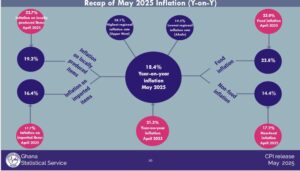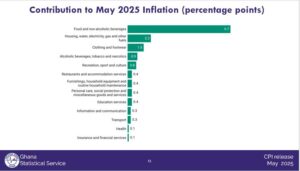By Juliet ETEFE ([email protected])
Headline inflation eased further to 18.4 percent in May 2025 from 21.2 percent in April, marking the fifth consecutive month of year-on-year decline and the lowest rate since February 2022.
This signals a steady return to price stability, offering relief to households and improved predictability for businesses and investors.
The monthly inflation rate also eased slightly to 0.7 percent in May from 0.8 percent the previous month, according to the Ghana Statistical Service (GSS).
Addressing the press, Government Statistician Dr. Alhassan Iddrisu noted that this sustained disinflation is possibly being influenced by a combination of macroeconomic factors including a strengthened cedi; tighter monetary policy; fiscal consolidation; and positive market sentiments.
“We remain cautiously optimistic that this trajectory will continue, offering relief to households and creating a more stable environment for businesses and investors,” Dr. Iddrisu noted.
Government’s 2025 budget aims to bring inflation down to 11.9 percent by December 2025.

Food and non-food inflation
Food inflation, though still high, dropped to 22.8 percent in May from 25.0 percent in April, while non-food inflation saw a sharper decline to 14.4 percent from 17.9 percent. Food alone accounted for nearly two-thirds of the overall inflation figure, contributing 9.7 percentage points to the 18.4 percent headline rate.
Non-food components – particularly transport, housing and utilities – also moderated. Transport inflation dropped from 14.9 percent in April to just 3.1 percent in May, representing the sharpest year-on-year decline (11.8 percentage points) across all CPI divisions.
Goods vs services inflation
Inflation in goods continued to outpace services, with goods recording a rate of 20.1 percent compared to 14.3 percent for services. Goods accounted for nearly 79 percent of the overall inflation, reflecting persistent cost pressures in consumer items – especially non-durables such as food, beverages and personal care products.

Within the goods category, non-durable goods posted the highest inflation of 21.8 percent, contributing 10.1 percentage points to the headline rate. Durable goods registered 6.1 percent inflation while semi-durable goods stood at 19.1 percent.
Core inflation, which excludes volatile components like energy and food, eased to 18.5 percent in May from 19.5 percent in April, indicating a broad-based decline in underlying inflationary pressures.
Locally produced vs imported goods
The inflation rate for locally produced items in May 2025 was 19.2 percent, down from 22.7 percent in April 2025.
On a monthly basis, inflation for locally produced goods was 0.8 percent; slightly higher than the 0.6 percent recorded for imported items.
Regional performance
Of the16 regions, 15 recorded a year-on-year decline in inflation. Ahafo Region posted the lowest inflation at 14.5 percent while Upper West Region continued to grapple with the highest inflation, reaching 38.1 percent.
Contributing factors in Upper West included food (43.9 percent), education services (57.6 percent) and housing and utilities (124.3 percent).
Greater Accra, Ashanti and Eastern Regions contributed the most to national inflation due to their higher weights in the CPI basket.
Top price drivers
Yam, smoked herring, fish and seafood, vegetable oil and ginger were among the top contributors to May’s inflation. Though ginger recorded the highest price increase at 139.1 percent, it ranked fifth in terms of overall contribution.










